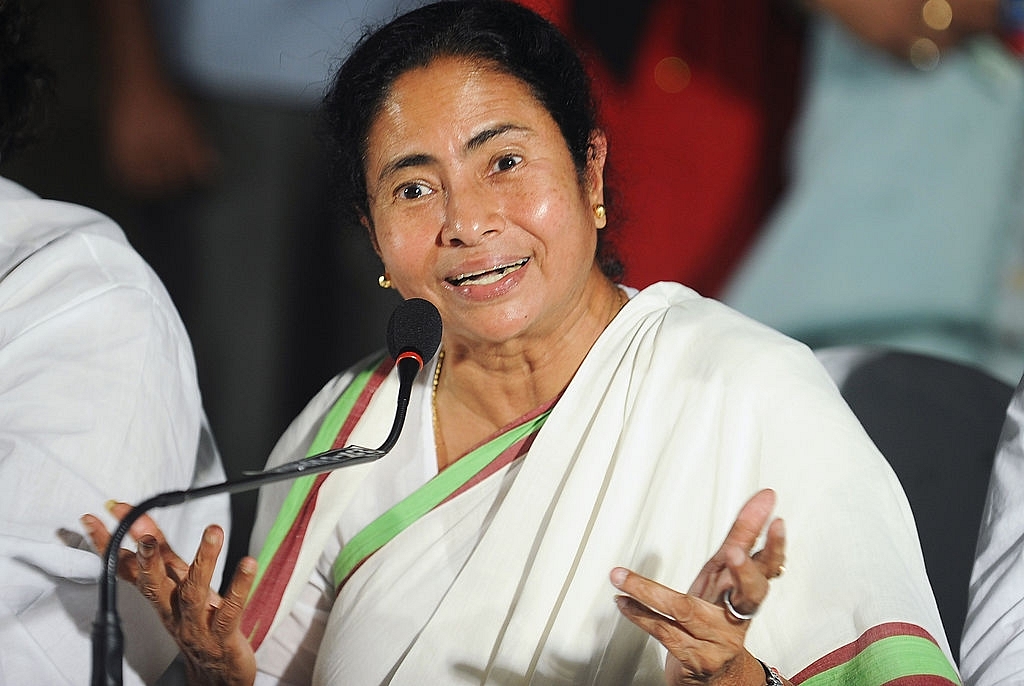Economy
Modi 3, Mamata 0; How Government’s Flexibility Neutralised Didi’s Efforts To Derail GST
- The first year of GST will test the nerves of both centre and states, with many bugs and issues likely to surface during implementation. This is Modi’s final challenge in 2017-18.
- One hopes Banerjee does not keep throwing more spanners in the works. Modi will have to work to isolate her capacity for damage.

Banerjee gestures as she address a press conference in Kolkata. (DIBYANGSHU SARKAR/AFP/GettyImages)
If there is only one act you would want to applaud the Narendra Modi government for, it should be about the extraordinary way in which it has brought the goods and services tax (GST) so close to reality.
Touted as the biggest tax reform in India’s history, GST is essentially a political project as big as the euro for Europe. That a leader like Modi, who is routinely opposed politically by so many other parties, could bring the effort so close to fruition shows how accommodative he has been on states’ concerns. At the meeting yesterday (16 January) with state finance ministers, Arun Jaitley ensured consensus on the ticklish issue of dual control, with a new compromise formula being agreed.
Under the deal, the centre will scrutinise and audit only 10 per cent of the GST taxpayers under a turnover limit of Rs 1.5 crore, while states will get to handle the other 90 per cent. For turnovers above Rs 1.5 crore, the scrutinising powers are 50:50 between centre and states.
It is surprising that even when the centre has been so generous about sharing control of assessees, West Bengal Finance Minister Amit Mitra, a former industry association head, found himself carping about states not being given 100 per cent control of assessees below Rs 1.5 crore. This churlishness surely comes from his boss Mamata Banerjee, who has taken it upon herself to oppose everything the Modi government proposes, even things that are good for her state.
It is worth recalling that West Bengal inexplicably refused to pass the GST amendment bill last August, after claiming to back it, obviously due to political issues with the Modi government. Luckily, the bill had already been passed by many states by then, reducing Didi’s capacity to block it indefinitely.
In November, when the GST talks were well underway, Mitra threw sand in the engine by claiming there was a trust deficit since the centre had hidden some information from the states on the number of service tax assessees. At this stage, there was still scope for derailing the GST timetable, for the Left Front in Kerala was also willing to play hardball. Again, it is the centre’s statesmanship and willingness to compromise that spiked Didi’s guns.
Put simply, at least three major attempts by Didi to embarrass the Modi government on GST have failed due to the government’s flexibility in meeting state demands.
But Didi or no Didi, GST is now likely to be a reality by 1 July, with only some issues – the laws for implementing GST and deciding the specific rates for over 1,400 dutiable goods and services – up for final negotiations. After that states will have to pass their own GST laws and we are on.
In the last lap, GST could essentially be an India versus West Bengal bout, if the hurdles erected so far by that state are any guide. Tamil Nadu, the other holdout, seems to have piped down after the demise of J Jayalalithaa. The new Chief Minister obviously feels the need to have friendly relations with the Modi government and will not rock the boat unnecessarily.
Hopefully, the next meeting of the GST Council, scheduled for 18 February, will cross the remaining hurdles, with or without Didi playing spoilsport. The weighted voting that requires 75 per cent of states to back any decision of the council will ensure that one or two spoilers cannot derail everything.
GST is one of the most remarkable achievements of the Modi government and could not have happened under any other dispensation at centre and states.
Modi’s conversion to the cause of tax reform, and the existence of several BJP state governments in major industrial states (Gujarat and Maharashtra, in particular) is what ensured the passing of the GST constitutional amendment. This core BJP constellation of powers, aided by poor opposition-ruled states like Bihar, UP and Odisha, has ensured GST’s progress so far.
The central government has also bent over backwards repeatedly to ensure state support for the reform, by first agreeing to multiple rates (instead of just three) and now to substantial state control of tax scrutiny and assessments. The Modi government also agreed to full compensation to states losing revenues for five years – something that UPA finance ministers dragged their feet on.
However, we need to be clear that the first year of GST will test the nerves of both centre and states, with many bugs and issues likely to surface during implementation. An unprecedented and extraordinary reform cannot succeed without a responsive tax administration.
This is Modi’s final challenge in 2017-18. One hopes Mamata Banerjee does not keep throwing more spanners in the works. Modi will have to work to isolate her capacity for damage.
Introducing ElectionsHQ + 50 Ground Reports Project
The 2024 elections might seem easy to guess, but there are some important questions that shouldn't be missed.
Do freebies still sway voters? Do people prioritise infrastructure when voting? How will Punjab vote?
The answers to these questions provide great insights into where we, as a country, are headed in the years to come.
Swarajya is starting a project with an aim to do 50 solid ground stories and a smart commentary service on WhatsApp, a one-of-a-kind. We'd love your support during this election season.
Click below to contribute.
Latest